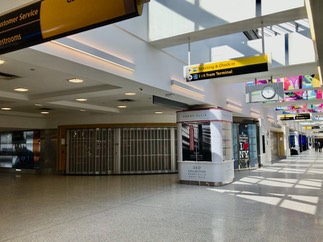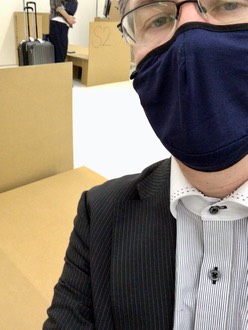This is not a piece about film, but friends suggested I post it as a kind of public service, reporting on what it was like to fly to Japan in early July 2020 during the COVID-19 pandemic. I’ll add a little extra about movies at the end. This account is also somewhat of a continuation of my series of posts about Japan during the pandemic, which I hope you can look at here and here.

My wife (who is a Japanese national) and I were pretty sure we were not going to be able to make our yearly summer trip back to Japan, but issues arose with our house in Yokohama and there were strong fears I would lose my permanent resident status if I didn’t return. So we dug into our pocket and bought tickets. The first flight to Haneda was cancelled, so we had to rebook to go to Narita. We left on Monday, July 6, from New York. Terminal 7 at JFK (photo to the right) was empty with only one of the many shops open. I think there were only four flights leaving that day from the terminal. We flew ANA to Narita, and they boarded us in groups to avoid too much mixing. Still, probably only a third of the seats were occupied, even in economy. So whether this was intentional or not, social distancing was rather easy. We wiped everything down, wore masks, used hand sanitizer constantly, and cut down on the trips to the bathroom. Everyone wore masks, but a few wore hazmat suits and/or protective shields or goggles. We debated whether to eat the inflight food, but decided it wasn’t different from eating the food we’ve had delivered at home. The only problem is I stupidly kept on forgetting to put my mask back on after eating! It was a good flight, but it was hard to sleep so I watched a bunch of movies (more on that later). The flight arrived early probably because there is much less international travel.

Before arrival, we had to fill out a number of forms about our health and where we've been and where we're staying. After arrival, they divided us into three groups: those transferring to another flight, those who could return home in Japan without using public transport, and those who could not. We were in group 2, so we got off second. Since there were few flights arriving at that time, we got through the quarantine procedures pretty quickly. First we went to a desk where a man—quite a jovial fellow—checked our forms and explained the guidelines about needing to quarantine for 14 days after arrival (we then had to sign a form saying we understood them). Those who could get back to their homes in Japan without using transportation could quarantine at home, while those who could not had to quarantine at a hotel. They then sent us to a booth for the PCR test, which was over in a minute. We then went through immigration.
Citizens from most nations are banned from entering Japan now, but I got in for two combined reasons: I have permanent resident status in Japan and I last left Japan before April 2, when the ban took effect. There has been strong criticism of Japan for blocking even permanent residents and spouses of Japanese nationals from returning to Japan as part of its effort to stem the pandemic, measures that many other economic powers have not taken (see some articles here and here). Japanese nationals are just as likely to bring in the virus as permanent residents, so the restriction is not really logical. The primary exception is if you left Japan before the ban took effect, but even then the rules only said that “in principle” you could return. And there were many who had to leave Japan after April 2 because of deaths in the family or other urgent matters, but could not return even to their jobs or families in Japan. The Ministry of Justice finally offered some examples of cases in which a person could be readmitted on humanitarian grounds, though those remained vague and didn’t solve the fundamental problem.
So I didn’t feel happy about my “privilege” in being able to return, but I also remained worried. I had called the Immigration Information Center from the States to confirm I could still re-enter Japan and they said I could, but the point of these regulations is often to leave a lot of power in the hands of the local bureaucrat. So I proceeded to Immigration with some trepidation. And true to form, Immigration proved to be much less amiable than Quarantine. I went to the booth for reentry, where the frowning officer made me sign more forms than I usually do, only to then be called to a separate office “for more explanation about COVID-19 policies.” There I was forced to wait as they pored over my passport. There was another non-Japanese national there, who was on the same flight, and he said he lived in Tokyo with his wife, but had been forced to teach his Tokyo classes online from the USA for the last few months. When officials asked him for his birth certificate, I quietly panicked because I did not bring such documentation. In the end, the officials mysteriously let me go after about 20 minutes without saying a word. They said nothing about the ban and did not query me about my departure last fall, my reasons for returning, or when I’d next leave Japan.

The next issue was getting back to our home in Yokohama. The authorities really don’t want people using public transportation from the airport, so a Quarantine officer accompanies you until they’ve confirmed you’ve gotten on to accepted transportation. Apparently it was reported that in the first days after the pandemic border controls came into effect, some people who promised not to take public transportation did anyway. You can’t take the train, use the buses, or take a taxi. You can rent a car, but our house is a good 90 minute plus drive from Narita, so we didn’t want to do that on jet lag. One friend’s family drove all the way from Kyoto to pick her up at Narita. Luckily, Quarantine had recommended a livery service that was equipped to handle these cases. Humorously, the web URL of the service even says “coronataxi.” Our plane was early, however, so our car had not yet arrived. So they took us to the North Wing of Terminal 1, which is closed, where the baggage claim area had been converted into a waiting area. It was full of the cardboard beds we had heard about (photo to the right). The PCR test results do not come in for 2-3 days. Those of us who can go home can get the results at home, but those who can’t go to a hotel by the airport to wait. There are some who can’t afford the hotel, so they apparently stay in this area. Thankfully, there was free food and drink available.

After about an hour waiting there, our car arrived and we were led out (I think the officer even took a photo of us getting in the car). It was a large RV with plastic separating the driver seat from the back. On the plastic divider was a sticker saying: “Measures against viruses have been completed in this car." It was a smooth ride, but it did cost an arm and a leg.
So we’re at home in Yokohama waiting for the end of our 14-day quarantine. We were surprised when the Quarantine officer told us we could still go to the supermarket to buy food or do some exercise in the neighborhood, so we are not in strict isolation. It seems rather odd, because people here are definitely not practicing social distancing like we saw in Connecticut. We have to report our health to Quarantine every day, but we can do that using the Line application (otherwise they call you once a day). We got the results of our PCR test in two days: both of us were negative.
So it was a strange trip, unlike any I had ever taken. And we have to return to the USA in a few weeks, though US entry regulations will be different. Still, we will have to be careful as we fly in the days of the pandemic.
EXTRA!

Okay, I should at least write about the movies I saw on the plane, all of which were Japanese films. First was Shinkai Makoto’s Weathering with You (2019), which was technically superb, especially the animation of water, but I still don’t think Shinkai, as with Your Name, is fully thinking through the problems of nation, memory, and responsibility. Second was the film I liked the most: Fictitious Girl’s Diary: The Movie (Sumida Takashi, 2020—poster to the right). Written by and starring the comedian Bakarhythm (who appeared in a controversial TV commercial I wrote about before), the film is a condensed version of the late-night TV drama in which Bakarhythm—who is a man—plays an “office lady” (OL) in a bank. While some problems remain with the film, it is a light, unpretentious, and in many ways quite perceptive narrative of the everyday matters of work and life—and of gender. The third film was the all-star spectacular Masquerade Hotel (Suzuki Masayuki, 2019). I am usually not excited by these big productions generated by media conglomerates (this time Fuji TV, Shueisha, etc.) and based on a popular mystery novel (this time by Higashino Keigo), but even with all its preaching about the supposedly high standards of police and hoteliers, it was still rather enjoyable. I haven’t seen too many recent popular Japanese films that cross the axis so much. Finally, I watched Wotakoi: Love Is Hard for Otaku (2020), which I viewed primarily because I have written about Japanese film musicals before (see my article here). I have not been impressed by the work of director Fukuda Yuichi, who is supposedly celebrated for his handling of comedy, and my feelings were confirmed with this film: while it was good to see a musical that recalls the classical “dual-focus narration” that Rick Altman, one of my Iowa profs, writes about with regard to musicals, both the comedy and the musical numbers were haphazard, unskilled, and slapdash.
I wonder what I'll watch on the return trip.

